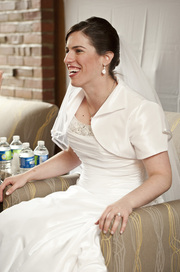Ceremony
|
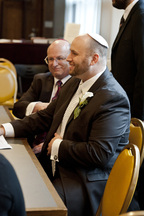
The Groom's Tisch, reception, will be held at a table full of food and drink. Seated adjacent to the groom are his father and the bride's father. Around the table are traditionally male guests (but we're egalitarian, so women are welcome!), relatives, and friends, who toast the groom and sing.
It is customary for a groom to deliver (or attempt to deliver) a dvar torah (a brief Torah lesson) at the tisch ("table"). But he'll be interrupted by his friends shortly after beginning, with lively singing and rhythmic clapping in which all present join to prevent him from continuing. This custom is not intended as an affront or as an act of disrespect to the groom, but is designed to protect the groom who may be less than scholarly, lest he be shamed on what should be his most joyous day. While we won't worry about Josh being less than scholarly, feel free to interrupt with songs!
It is customary for a groom to deliver (or attempt to deliver) a dvar torah (a brief Torah lesson) at the tisch ("table"). But he'll be interrupted by his friends shortly after beginning, with lively singing and rhythmic clapping in which all present join to prevent him from continuing. This custom is not intended as an affront or as an act of disrespect to the groom, but is designed to protect the groom who may be less than scholarly, lest he be shamed on what should be his most joyous day. While we won't worry about Josh being less than scholarly, feel free to interrupt with songs!
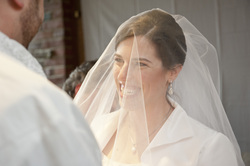
The Bedeken - The Veiling Ceremony
The groom is then escorted by his father, the bride's father, and his friends to the bridal reception area for the veiling ceremony, known in Yiddish as the bedeken. Accompanied by his friends, who dance and sing in front of him, the groom leads the procession to the bride. He approaches the bridal throne and covers the bride's face with a veil. He is then escorted back to the groom's reception room by the men, to prepare for the huppah ceremony [the public marriage ceremony that takes place under the marriage canopy, or huppah].
The veiling ceremony dates back at least to early medieval times, and some find a reference to the custom in the Talmud. The reason for the ceremony is probably related to modesty; the veil symbolically represents the added level of modesty the bride is expected to adopt with her elevation to the married state. The Torah relates that when Rebecca saw her bridegroom Isaac coming toward her, "she took her veil and covered herself".
Watch the video below to see the groom being danced in to his bride (no, we don't know the couple - just found them on YouTube!). Want more examples? Put "bedeken" into YouTube.
Things You'll See During the Ceremony
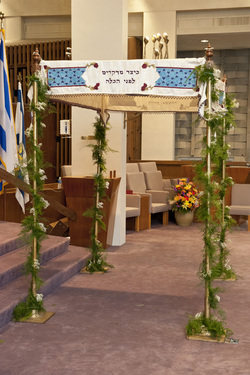
Kippah and Tallit
The kippah (yarmulke) is the Jewish head covering and the tallit is the prayer shawl. Both are worn as a sign of respect during ceremonies.
The tallit that Josh is wearing today is the one that Rachel made him, as an engagement gift. Many of the pieces of the tallit were purchased together on their trip to Israel in February of 2011. The final touches of the tallit were done on Josh's mom's sewing machine.
Chuppah
The chuppah (wedding canopy) is intended to create an intimate, sanctified space symbolizing the home that the bride and groom will share together. The sides are left open to signify that all friends and family are welcome into their new life and home.
Our chuppah was made by Josh's mom, Marianne, along with family friend Miriam Shazeer, for Miriam's daughter's wedding. It has since been used at two other weddings - and we are honored to stand under it at our wedding and to be married under the canopy that Josh's mom helped create.
You can see more pictures and read more about our chuppah here.
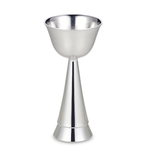
Kiddush Cup (with Wine)
During our ceremony we share a glass of wine from our Kiddush cup (ceremonial cup). The sweetness of the wine represents the sweetness of our love for each other.
Ritual of the Ceremony
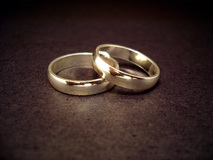
The Kiddushin: Betrothal
The first part of the wedding ceremony begins with the blessing over the wine, a traditional Jewish symbol of simcha (joy). Rachel and Josh will share their first cup of wine, symbolic of the joy they will share in their marriage. They then exchange rings.
Nissuin: Nuptials
The second part of the ceremony consists of the recitation of the Sheva Brachot, seven blessings. The blessings include a blessing over the wine, the creation of the world and for the bride and groom as individuals and as “beloved companions”, united in joy and gladness, laughter and song, dancing and jubilations, love and harmony, peace and friendship.
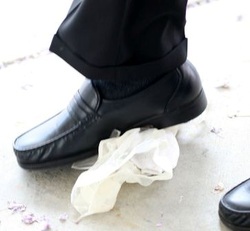
Breaking of the Glass
Following the Sheva Brachot, Rachel and Josh will once again drink from the cup of wine… Josh then breaks a glass with his foot. The custom of breaking the glass has many interpretations. A broken glass cannot be mended; likewise the promises made by Rachel and Josh are irrevocable. In this context, the glass is broken to protect the marriage with an implied prayer, “As this glass shatters, so may our marriage never break.”
After the Ceremony
Unlike other weddings you may have been to, there is no "reverse processional" from the wedding canopy. There is hugging and dancing and singing - and after the bride and groom have been danced to the Yichud Room (see below), we invite you to join in the celebrating!
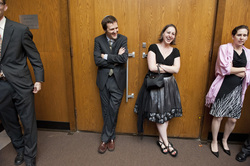
Yichud
The yichud (seclusion) takes place immediately after the ceremony. The bride and groom retreat to a private room to share their first few moments alone together as husband and wife.
Friends will be asked to guard the room, to give the bride and groom a few minutes of privacy before they are overwhelmed by well-wishing guests.
Reception - you can read all about the reception here. Get ready to celebrate!
Many thanks to MyJewishLearning.com for providing the basis for this information. For more information, and to read the article "Being a Guest at a Jewish Wedding", visit them here. The pictures of our wedding were taken by Simi Rabinowitz.
